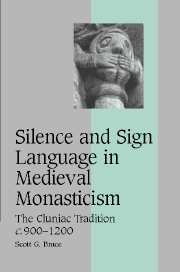Book contents
- Frontmatter
- Contents
- List of tables
- Acknowledgments
- List of abbreviations
- Map
- INTRODUCTION: THE DORMANT LANGUAGE
- 1 UTTERING NO HUMAN SOUND
- 2 THE TRAINING OF THE HAND
- 3 A SILENT COMMERCE OF SIGNS
- 4 TRANSMISSION AND ADAPTATION
- 5 CONTINUITY AND CRITICISM
- CONCLUSION
- Appendix A: The Cluniac sign lexicon
- Bibliography
- Index
- Cambridge Studies in Medieval Life and Thought Fourth Series
2 - THE TRAINING OF THE HAND
Published online by Cambridge University Press: 16 July 2009
- Frontmatter
- Contents
- List of tables
- Acknowledgments
- List of abbreviations
- Map
- INTRODUCTION: THE DORMANT LANGUAGE
- 1 UTTERING NO HUMAN SOUND
- 2 THE TRAINING OF THE HAND
- 3 A SILENT COMMERCE OF SIGNS
- 4 TRANSMISSION AND ADAPTATION
- 5 CONTINUITY AND CRITICISM
- CONCLUSION
- Appendix A: The Cluniac sign lexicon
- Bibliography
- Index
- Cambridge Studies in Medieval Life and Thought Fourth Series
Summary
Early medieval monks could imagine the ideal community of the faithful. The author of The Voyage of Saint Brendan, a tenth-century moral tale about an Irish monk who sailed the uncharted western sea, depicted it far away on a lonely island, a journey of many months from any known land. St. Brendan had been there. The holy man and his entourage had found the island as they sailed in search of the promised land of the saints. On the beach an old abbot greeted them with kisses and, without a word, led them to his monastery. At the gate he made it known with a movement of his hand that silence was the guiding principle of the place. “Guard your mouths from speech,” Brendan warned his followers, “lest your foolish words pollute these brothers.” The monks who lived on the island never conversed with one another. Instead, their hearts told their abbot all that they needed and he responded by writing on a tablet. “We came to this island eighty years ago,” the old man said, breaking his silence to converse with Brendan, but speaking with the utmost reverence and humility. “We have heard no human voice except when we sing praises to God. Among the twenty-four of us, no voice is raised unless one of the older monks makes a sign with a finger or with the eyes.” The unwavering discipline of these monks had an awesome efficacy.
- Type
- Chapter
- Information
- Silence and Sign Language in Medieval MonasticismThe Cluniac Tradition, c.900–1200, pp. 53 - 76Publisher: Cambridge University PressPrint publication year: 2007

